The most common type of engineered wood is a flooring with a real wood layer on top and an engineered wood layer as the base.
There are three types of construction and two main finishes to consider when choosing this type of non-toxic engineered wood floor.
When looking for a zero-VOC, healthy engineered wood floor, the most important part is the construction type. The lowest VOC types are those with a plywood base or solid slate base. The lowest offgasing finishes are the UV-cured water-based finishes.
Certifications like GreenGuard Gold don’t matter to me here because the highest offgassing engineered wood can meet this level. The lowest offgassing options are zero-VOC.
This article contains affiliate links, upon purchase I make a small commission at no extra cost to you.
Three Types of Engineered Hardwood Flooring
1. Plywood Construction
This is one of the construction types you should look for, as these floors can meet zero VOC.
The most common type of engineered hardwood floor has a plywood base.
The core is made of plywood and a top layer of real wood is glued on. The real wood top layer can range in thickness from 1mm up to 6mm.
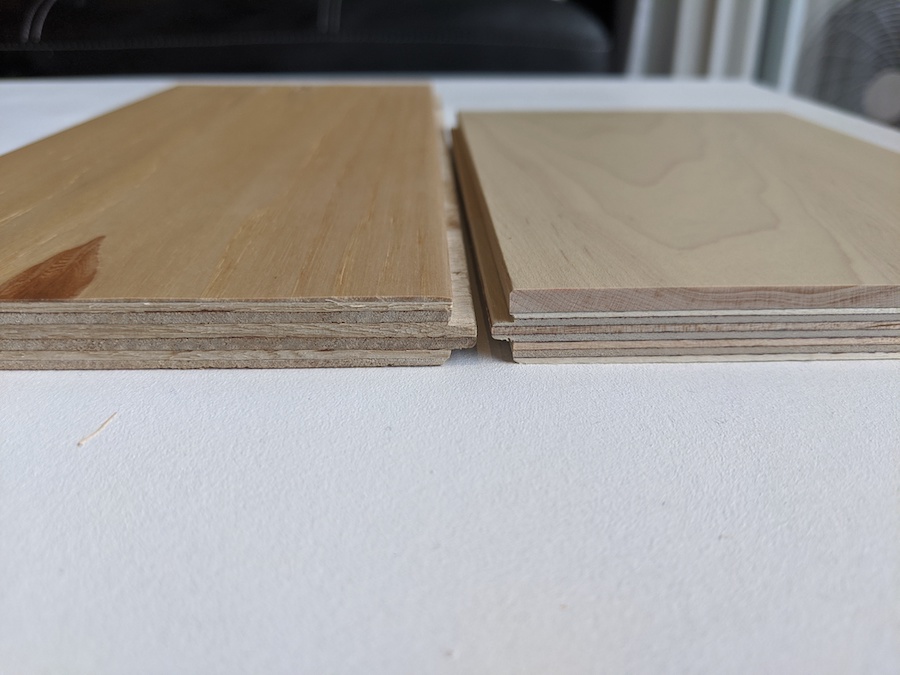
The plywood which is made with phenol-formaldehyde adhesive usually, is done offgassing by the time makes it way to the flooring company and then to you.
Though look out for brands that use a plywood with MDF (medium density fiberboard) in some of the layers as this offgasses more formaldehyde.
In general, this type of engineered wood flooring is safe for almost everyone including most people with chemical sensitivities.
Some who are extremely sensitive may notice that this type of flooring can have a little bit higher odor than say a solid hardwood floor.
This is partly due to the odor of the pine/spruce/fir used to make the plywood, but it’s possible there are some slight remnants of the glues that those who are extremely sensitive can pick up.
(Either the glue of the plywood or the glue used to attach the top layer of wood). Especially if the batch you get is very fresh.
While the vast majority of brands have a pine/spruce/fir plywood core, Cali Floors Meritage line uses layers of acacia and eucalyptus woods as the core for the ply. I do think this has a milder odor than spruce/pine/fir myself. I would encourage you to get samples of both types if you are sensitive to the natural odorants of wood.
This is usually the type to choose for those wanting a non-toxic hardwood floor and for most people with sensitivities. Those who are extremely sensitive might want to look at the second construction type which has less glue.
The brands can claim zero VOC on this type of construction.
Example Brands:
- Cali Bamboo Meritage – Oak $9.99 / sqft
- LL Flooring – Plywood core types
- Shaw Castlewood – Hickory $9.09 /sqft
- Johnson Hardwood Vineyard – Hickory $6.05 /sqft
- Anderson Imperial – Pecan $5.99 /sqft
- Johnson Hardwood Toscana – Hickory $5.95 /sqft
- Johnson Hardwood Toscana – Walnut $5.95 /sqft
- Western Skies European Oak $5.70 /sqft
- Mannington Park City – Oak $5.55 /sqft
- Smokey Mountain Engineered – Oak $5.29 /sqft
- Pioneer Engineered – Oak $5.29 /sqft
- Western Skies Engineered – Maple $5.09 /sqft
- Shoreline Engineered – Birch $3.60 /sqft
- Johnson Hardwood Wilderness – Birch $2.65 /sqft
- Kahrs
Here is an overview of engineered floors in under 5 minutes!
2. SPF Quarter Sawn Construction
Another great option for those sensitive to glues/VOCs, this option is slightly preferable to the plywood base.
A far less common construction type has a core of quarter-sawn spruce, pine, and/or fir (SPF) softwood wood species.
The wood is cut and laid in “pickets” (i.e. it’s strips of solid wood) which run perpendicular to the solid hardwood top layer.
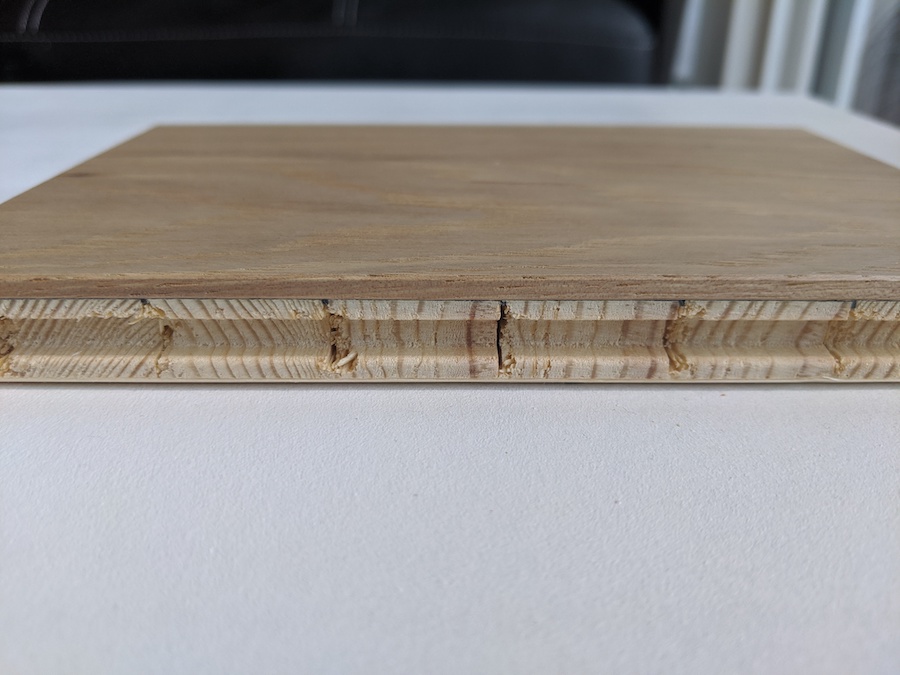
While the hardwood top layer is still of course glued on, and there might be a stabilizing layer below the quarter-sawn layer, there are no glues within the main core layer.
This core can also be called “solid cross slat core” or “lumber core” at LL Flooring. Technically this is also a ply of three layers but it’s distinct from the usual plywoods which have thinner layers (and usually more layers).
For those extremely sensitive to the natural odorants of wood or the glues used in plywood, you might prefer this type.
For most people, it’s not necessary to track this type down and I would choose plywood construction in most cases (for availability and price and because it’s zero-VOC as well). But for those wanting to go the extra mile, this is definitely one to get a sample of.
These brands should not have any offgassing and this type of construction should be formaldehyde-free (or more accurately no added formaldehyde in any of the components, since wood naturally contains some formaldehyde).
Tesoro uses pine in the middle solid layer, and a thin layer of ash as the stabilizing layer below.
Example Brands:
- LL Flooring – Lumber core types
- Tesoro Coastal Lowlands – White Oak, Hickory, Maple, Walnut $9.31 / sq ft
- Tesoro Great Southern Woods starting at around $7 / sq ft
- Tesoro Great Northern Woods starting at around $7 / sq ft
- Mirage Hardwood Trubalance $6 – $8.50 / sq ft for most species
- Kahrs, many lines
3. HDF Core Construction
The last type of engineered wood flooring has the same top level of real hardwood but in this case, it’s glued to an HDF (high-density fiberboard) core. (Or sometimes MDF, medium density fiberboard core, which is very similar).
Sensitive folks may not be able to use most brands of this type of engineered wood flooring because of the formaldehyde binder in HDF/MDF.
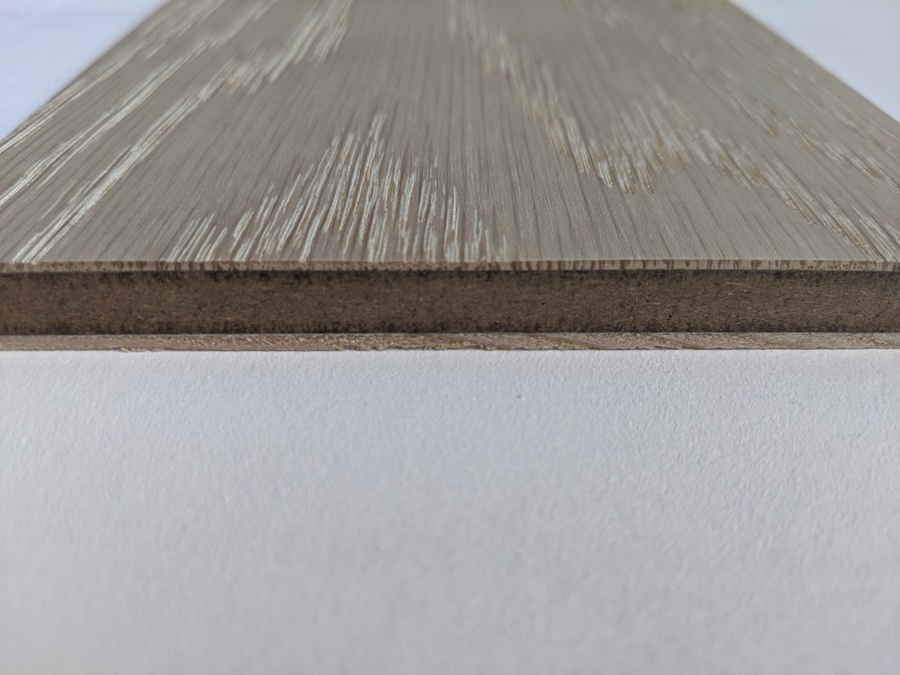
HDF is wood fiber that is glued and pressed together with a binder, almost always formaldehyde. It’s more commonly seen as the core of laminate flooring.
My post on laminate flooring goes much more into detail on the chemicals and offgassing of HDF. It’s possible that some floors are made with MDF which is very similar.
For this reason, this type is my least favorite type of engineered wood flooring and I don’t see any good reason to choose an engineered flooring that has some offgassing when we have better lower VOC options.
However, there are two brands that uses an HDF core that is not made with formaldehyde resins (no added formaldehyde). Kahrs and Mohawk including Pergo engineered wood floors like Pergo Defense + Engineered Hardwood. And the VOCs are extremely low.
The difference between laminate floors and engineered wood with an HDF core is that laminate does not have a top layer of real solid hardwood, just a printed image, and a melamine protective coating.
You can see the difference between the two in this picture:
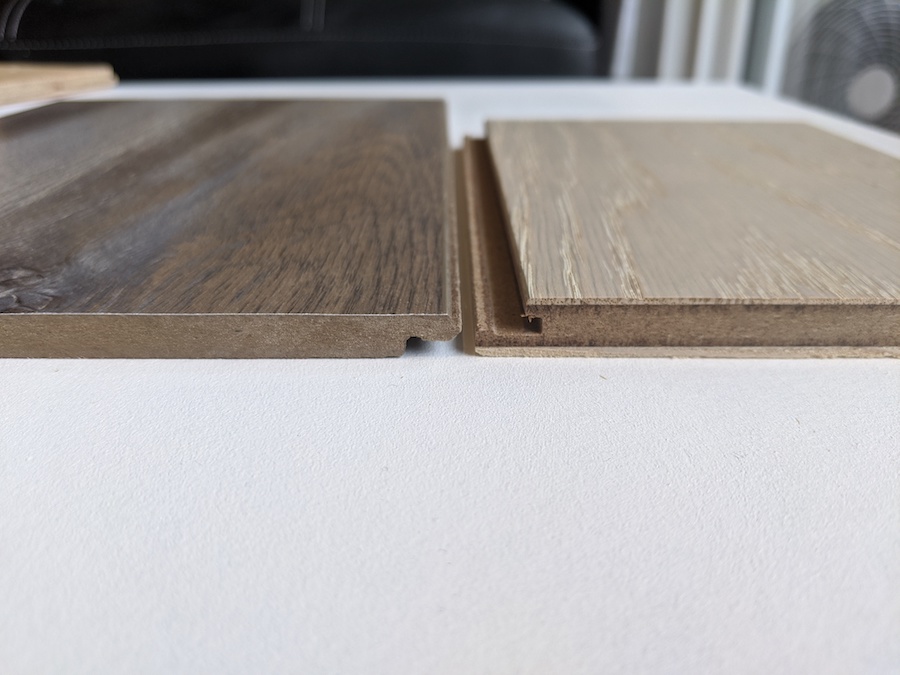
Example Brands:
- Mirage Lock HDF floors from Mirage Hardwood
- Shaw has some lines with an HDF core
- LL Flooring, some lines
- Some Home Depot Malibu Planks have an HDF core
- Tesoro Longevity Collection
- Valinge Engineered wood (advertised as 100% real wood, when it has an HDF (or MDF) core. Also advertised as formaldehyde-free though the HDF core is made with lots of glue.)
Two Types of Finishes on Engineered Wood Flooring
1. UV-Cured Polyurethane
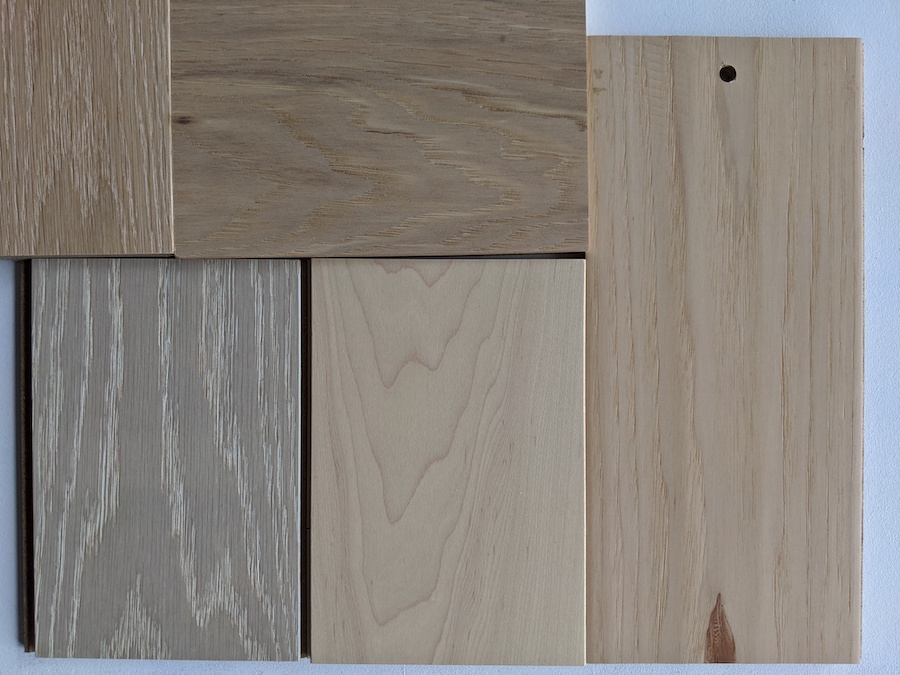
The vast majority of engineered hardwood floors have a water-based UV-cured polyurethane finish with aluminum oxide. This finish has no offgassing.
Sometimes it’s simply listed as “aluminum oxide” or just as “UV-cured finish”.
Example Brands:
Almost every brand, far too many to list!
Polyurethane without Aluminum Oxide
A similar finish is a water-based polyurethane (or polyurethane/acrylic mix) without aluminum oxide. These are not as durable as an aluminum oxide finished floor but they can be more natural-looking.
The aluminum oxide is not a health concern when in solid form embedded in the floor’s finishes. This finish is so durable it won’t usually show wear for decades. Though I do consider this a risk when (or rather if) the floors are re-sanded.
Example Brand:
- Kahrs Water-Based Finish Engineered Floors
2. Oil Based Finish
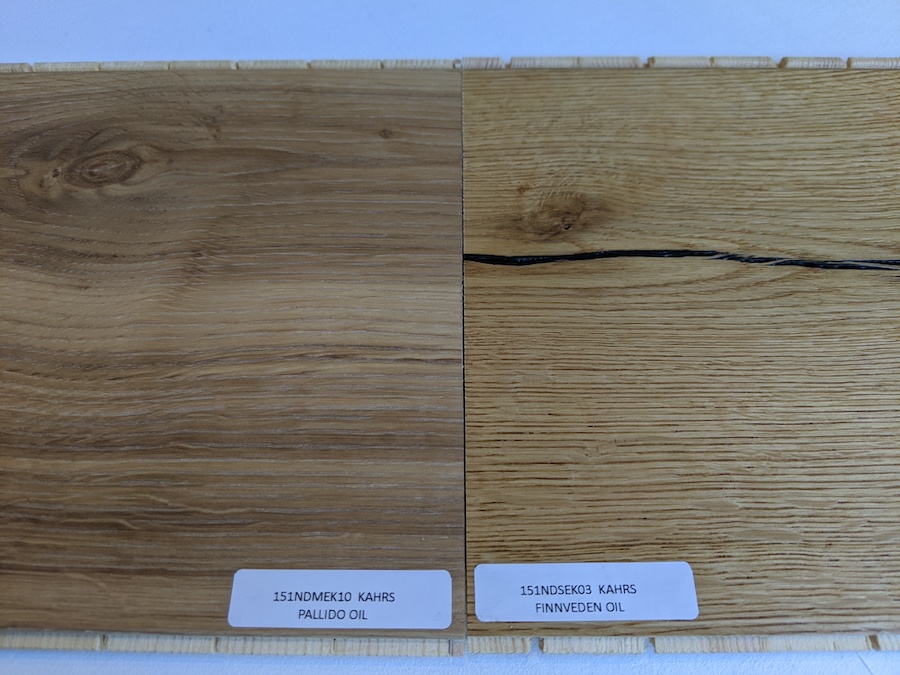
Oil-based finishes usually have some offgassing of VOCs, and you have to make sure you are OK with the maintenance oils.
A few brands have an oil-based finish on the wood. They often don’t say which brand of oil-based finish they have used.
A few do say that it is WOCA, I have seen some list the finish as UV-cured oil-based – which isn’t a specific brand, but the UV curing does speed up offgassing.
Kahrs and a few other brands list their oil finish as natural and/or zero-VOC.
I definitely can pick up the odor off of Kahrs oil-finished floors whereas I cannot pick up any odor off of polyurethane finishes.
Though keep in mind with the natural oil you do also smell more of the natural wood odor coming through (along with the oil itself), since the aluminum oxide blocks some of the wood odor. The Kahrs oil-finished planks have a very natural look and feel to them whereas Cali Floors Odyssey oil finish looked and felt like a UV-cured polyurethane with aluminum oxide. They say it needs an oil refresher as well.
This is also another way to avoid aluminum oxide, if you wish to avoid that.
Kahrs maintenance oil which looks to be all paraffin (kerosene), may not be tolerated though, so you do need to test out all of the maintenance products.
Rubio Monocoat maintenance oil is linseed based so it should be used over linseed oil finishes or to transition to linseed oil.
Example Brands:
- Cali Bamboo Odyssey Hardwood Flooring
- Pioneer Engineered Oak
- Kahrs Oil Finished Line
- Tesoro Brushed Patina Collection
Note! You can also find unfinished engineered wood flooring.
Other Additives to Consider in Engineered Flooring – Antimicrobials
Titanium Dioxide
At least one brand, Lauzon, uses titanium dioxide as opposed to aluminum oxide in the topcoat finish.
The idea here is that the titanium dioxide reacts with UV light and a PCO process occurs, which creates OH molecules that can break down germs, VOCs, mold, etc.
Sometimes this topcoat is labeled as air cleaning and sometimes as an antimicrobial finish.
Other
Possible antimicrobial additives in engineered wood floor coatings:
- Titanium dioxide (nano) (Nano-TiO2)
- Silver nanoparticle-loaded hydroxyl zirconium sodium phosphate (Ag-HZDP)
- Silver nanoparticle-loaded zeolite (Ag-Z)
- Far infrared ceramic nanoparticles (FICN)
- Zinc oxide nanoparticles (Nano-ZnO)
Companies using unspecified antimicrobial agents in the floor finish include:
- Mirage
- Breezewood floors
- Goodfellow
- Many more, I will add to the list when I come across them
Other Types of Engineered Wood Floors to Consider
1. Hybrid Flooring
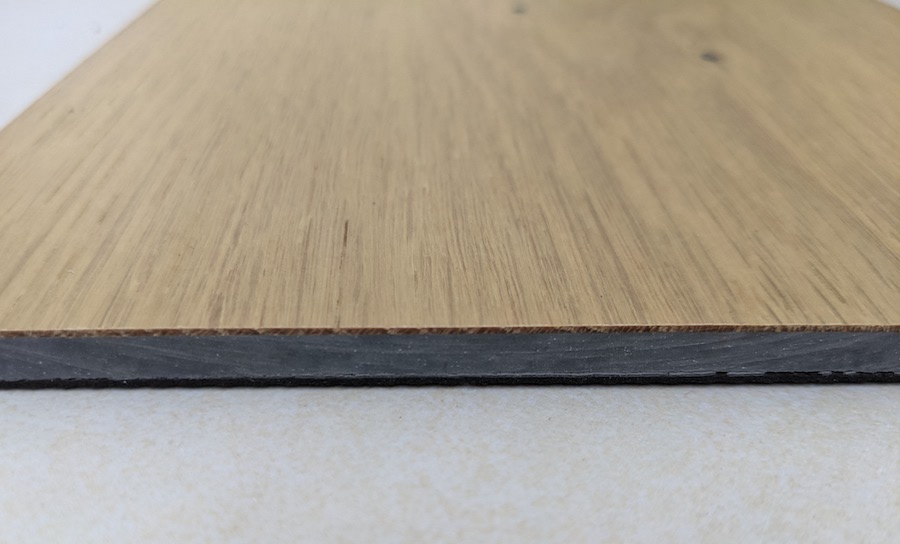
A hybrid flooring is a relatively new type of click-together wood flooring.
Like all engineered wood, it does have a real hardwood layer on top. In this case, it’s quite thin.
The core of the boards are not wood-based – they are an SPC – stone/PVC composite. This is the same SPC core that you find in luxury vinyl plank (LVP) floors.
I like this type of flooring if you want something waterproof, you want to cut down on plasticizers used in luxury vinyl by having a real wood top layer, and/or you want to cut down on the amount of wood in the floor.
Since plasticizers are semi-VOCs, they generally are not being released in gas form, but rather by leaching. Therefore, by having a physical layer of wood on top of the vinyl layer it could act like a block to the leaching.
(Here is a quick visual post showing how to identify engineered wood, versus laminates, vinyl, and hybrid planks).
Brands include:
- LL Flooring AquaSeal Bamboo, Oak (real wood top with SPC core) $3.99 / sq ft
- Geowood by Cali Bamboo – Starting at $5.79 / sq ft
- Tesoro Lakewood Composite – Starting at $7.60 / sq ft
- Shaw Floorté Waterproof Hardwood – around $9.59 / sq ft
- Opti-Wood from Home Depot – $3.39 – 4.09 / sq ft
- Raintree – $5.50 – 6.50 / sq ft
- AquaGuard from Floor&Decor – $4.69 / sq ft
- LifeProof from Home Depot (bamboo with SPC core) $4.15 / sq ft
- Acqua from Home Depot (bamboo with SPC core) $3.79 / sq ft
- Home Legend (bamboo with SPC core)
- Wellmade (bamboo with SPC core)
2. Engineered Bamboo Flooring
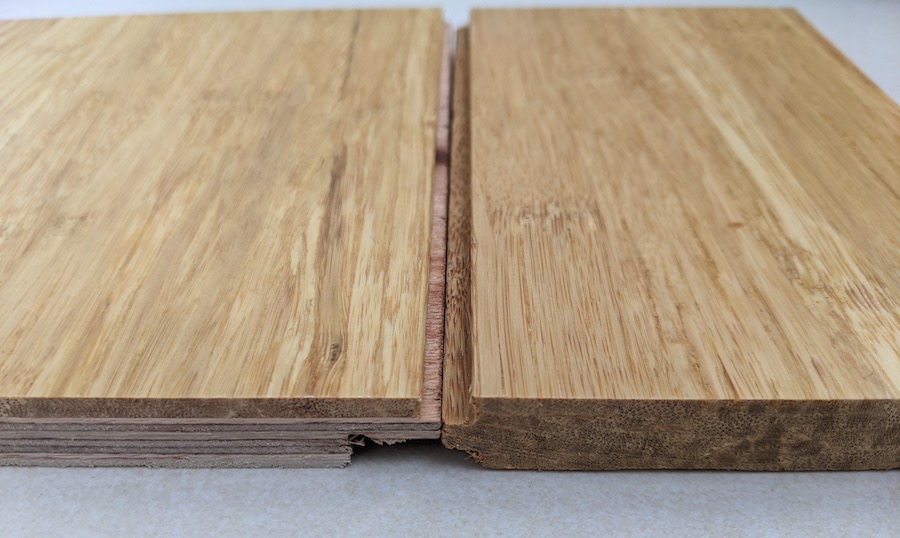
Solid bamboo or solid strand bamboo flooring is a type of engineered wood. Though bamboo is technically a grass, it’s similar enough to wood flooring.
A solid strand bamboo floor has various strands of bamboo glued together (pictured right). Sometimes it seems like it is a regular wood glue odor (similar to Titebond) and other times it seems like a different type of glue, maybe polyurethane.
Engineered bamboo (pictured left) is a flooring that has a top layer of bamboo over an SPC, plywood, or HDF/MDF core. I would avoid HDF/MDF cores if you want to go for the lowest offgasing options out there.
The topcoat is a UV-cured polyurethane or UV-cured acrylic urethane.
Brands:
- LL Flooring AquaSeal Bamboo (bamboo with SPC core)
- Floor and Decor AquaGuard Bamboo (bamboo with SPC core)
- LifeProof from Home Depot (bamboo with SPC core)
- Acqua from Home Depot (bamboo with SPC core)
- Home Depot’s OptiWood Bamboo (bamboo with SPC core)
- Home Legend (bamboo with SPC core)
- Wellmade (bamboo with SPC core)
- Home Legend has bamboo with a SPC core, HDF core, or solid strand
- Home Decorators Collection solid bamboo flooring
- Floor and Decor EcoForest solid strand bamboo
- Ecofusion solid strand
- Tesoro solid bamboo
- Tesoro engineered bamboo
3. Eucalyptus Flooring

Cali Bamboo Eucalyptus is strands of eucalyptus pressed together with a lot of pressure and heat in a wavy pattern. I pick up the regular wood glue smell but nothing that is different from all other engineered wood.
Tesoro also makes a solid strand eucalyptus floor.
A similar product is Tesoro densified poplar wood flooring.
4. Engineered Hemp Flooring
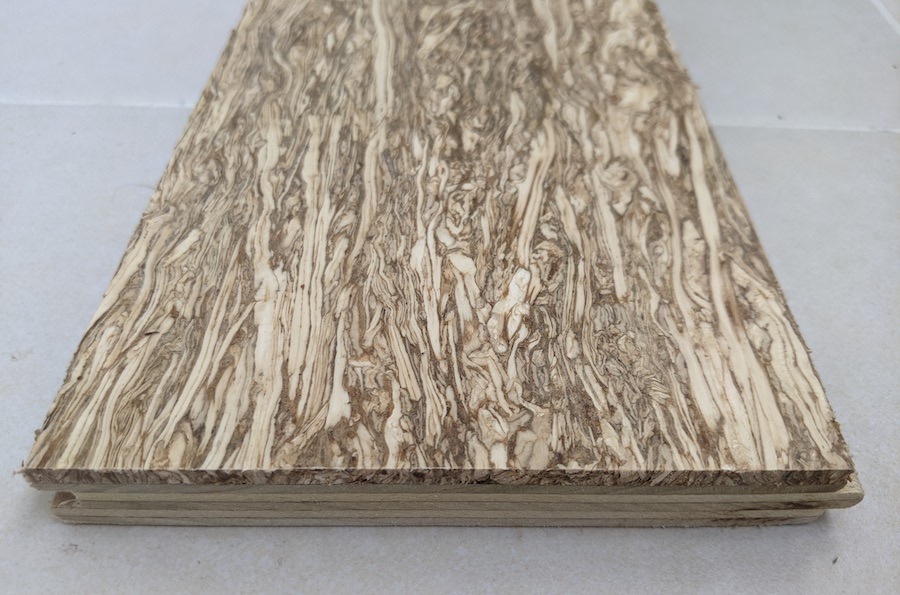
HempWood is a new type of flooring that uses hemp strands pressed and glued together as the top layer of the engineered floor. The base layer is the typical plywood construction.
The hemp layer is pressed together with a soy glue adhesive, similar to the soy adhesive used in PureBond plywood. It did have some glue odor to me which was very similar to Purebond (very mild, most people do OK with soy glue).
They claim that there are no added VOCs and no added formaldehyde.
One sample came finished with what looked like the typical water-based UV-cured polyurethane (or polyacrylic) coating and the second sample was unfinished.
The way it was fraying at the edges made me wary about its durability.
Installation of Engineered Wood
There are four main ways to install engineered wood.
- Floating Floor – in this method, the planks are clicked together and installed over an underlayment but not glued or nailed down. Tongue and groove glue is often used on the edges (Roberts is zero-VOC). This installation is good in that it is low toxicity, but the downside is that you usually can’t re-sand your floors.
- Nail Down – in a nail-down installation an underlayment is used and the floor is not glued down. This is my preferred installation method over wood subfloors.
- Glue Assist – this installation involves gluing down and nailing the floor. This is often used for wide planks and/or when there are big fluctuations in humidity. If you want to avoid glue, don’t go for wide planks. Glues can be silane-modified polyether or polyurethane. Silane modified is lower toxicity, but be sure to check the warranty for the floor.
- Glue Down – in this method, the glue is installed evenly on the floor. Many of the glues are polyurethane. Some are 0-VOC like Bostik Greenforce. This method is often used over concrete. I would not use this method on concrete personally, since concrete is always trying to dry inward. There are also reports of this type of glue curing very slowly.

Corinne Segura holds certificates in Building Biology, Healthier Materials and Sustainable Buildings, and more. She has 10 years of experience helping others create healthy homes.
If you would like to support the research behind this blog you can make a donation via Kofi!

Lois
Based on the Tesoro website it looks like the Great Southern Woods line is no longer available.
Corinne Segura, Building Biologist
https://tesoro-woods.com/product-category/wood-flooring/great-southern-woods/
Katie
Hi! I’m purchasing some Johnson hardwood floor (Denali manufacture?). It has a solid plywood core but not Greenguard/ gold certified. I’m not sensitive to VOC but I have kids and trying to get everything else in the kitchen Greenguard certified. I live in California so it’s all CARB 2 compliant. You do not feel like the Greenguard certification is as important in hardwood floors?
Katie
Awesome article! Thanks so much! I’m planning on ordering Johnson hardwood floors (Denali manufacture?). It’s a solid plywood core, but I’m not sure if the finish is water based and I don’t believe it’s Greenguard certified. I live in California so it will be CARB 2 compliant. Yo I do not feel that the Greenguard/ gold certification is a big deal? Thanks!
Corinne Segura
no greenguard is not needed
Robin Osullivan
Thank you for being so incredibly informative. I’m stumped on a few things in trying to get going on some home remodeling. One big issue is the safety and use of fire retardants as many sources say they’re cancer causing and so on. I just read that “fire resistant” engineered wood floors contain proprietary flame retardant chemicals. I’m also replacing my hvac ducts and see antimony listed on the safety specs on one brand that says it’s on the flame retardant. Should I be worried about flame retardant chemicals and how do I avoid them in flooring and duct work? Thank you!
Gina
Hi Corrine,
I just purchased a new home that had Mohawk Tecwood engineered wood floors installed in 2018 and I just found out that they have an HDF core. This is really worrying me and I’m too afraid to live in the house now. We were also planning to extend the floor into a couple of the rooms to replace carpet but I don’t feel comfortable installing new HDF. Do you think the current floors would have finished off-gassing in 6 years? Or is it better to have it all replaced with a safer option? Thanks!
Corinne
You may want to ask Mohawk which year they started using formaldehyde free HDF. Their new HDF used in their laminate is great. If it was formaldehyde-based glue in 2018 then yes it should be offgassed under normal conditions.
karen
iam about to buy floors that have an antimicrobial coat , is that safe or is toxic?
Corinne Segura
please scroll all the way down to the bottom to leave a new comment instead of replying to an unrelated comment. it depends on what the antimicrobial is made of
Lily
Hi Corinne,
I have been researching Valinge, and I’d love to hear more about your research into their product, which is claimed to be very low VOC. I’ve had a hard time digging deeper, However the product is recommended by Greehhome Solutions and another green builder in the Seattle area.
Corinne
I would never use a product with a HDF/MDF core myself. Also the MDF/HDF could be formaldehyde free, it’s possible, but that is not the the norm.
lisa
HI. I have neuropathy in my feet so Tile is NOT an option for our flooring in the basement or laundry room in the basement. It is too hard and too cold and I tried but I just cannot do it. I live in the Midwest with long cold and wet winters. Can you please tell me what non toxic flooring works in the basement? I would love to have a wood floor look but also due to health issues, need a non toxic floor. I also am visually impaired so reading all the comments and your articles is hard for me so I would appreciate any help you have to help me with this. I have tried but after hours of scrolling your articles and comments I find such contradicting information and I am more confused/. I am sure it is my chemo brain. Thanks Lisa
Cindy
Hi Corrine,
We are getting ready to install over 1800 square feet of engineered hardwood in a renovation project. I am currently on a detox program for trying to rid my body of black mold (previous exposure not due to current home). I have never heard this concern before about mold growing underneath hardwood flooring that is glued down on top of concrete subfloor. Yikes!! Please help.
Regarding the glue down method you stated “I would not use this method on concrete personally, since concrete is always trying to dry inward.” What is the best way to install this engineered flooring then to avoid any potential of mold growing underneath. We live in MI on a lake, so certain times of the year can be quite humid but it isn’t a year round problem.
In addition, a few of these areas where engineered wood was going to be glued down, it will be sitting on top of radiant heat flooring.
Now I am feeling so confused and wondering if we should not be putting this product down! Should we be going with a stone floor instead??
Any advice is greatly welcomed. Thank you!!
Cindy
Corinne
it’s a debatable topic. if your slab is truly dry them Cheryl Ciecko recommends the best bet is to go with a painted on vapor barrier instead of a plastic sheet since a plastic sheet can leave a space for mold to grow if it’s getting wet.
Cindy
Thank you Corinne for responding! I I will investigate what this painted on vapor barrier is. I have never heard of this.
Bridgett Novak
Could you please clarify your best suggestion for securing a hardwood, engineered wood or bamboo floor to a concrete subfloor? I would love to not use glue (since I’m concerned about the smell and toxicity)…but it seems it is at least partially necessary. Floating is apparently not as good…since the planks can move/fluctuate. Do you agree? THANK YOU!
Jennifer
Hi Corrine,
This post is super helpful in explaining all of the different Engineered Wood options. We’ve zeroed in on purchasing the Pergo Defense Plus Engineered Hardwood. It has an HDF core but the company told me that it has no added formaldehyde. Are there any other concerns I can ask the company about? Thanks!
Corinne
interesting, I’m adding it to the list, the only unknown there is what it the antimicrobial
Emily
Hi Corinne,
Just pulled the trigger on an engineered option thanks to your post – so helpful! It’s a plywood core with UV cured urethane topcoat. We are gluing down with Bostik greenforce. I’m still a little leery about the formaldehyde – it has all the standard certifications which I understand don’t pull too much weight. It’s not a big brand (Nuvelle) and the boxes say it was manufactured 3/2022, so more than a year ago. Is it safe to assume it’s already offgassed or is cured? I started panicking as I discovered NAF (no added formaldehyde) and ULEF (ultra low emitting formaldehyde) after the fact.
Any hesitations about lesser known brands?
Thank you!
Emily
Also curious if there are specific concerns to be aware of for flooring manufactured in Vietnam.
Corinne
most likely cured yeah, ask if made with phenol formaldehyde. no problems with Vietnam.
Scott
Hi Corinne,
Do you happen to know if UV cured urethane coatings might contain any PFAS? I assume it might depend on the manufacturer but I can’t find anything online. I’ve already ordered an engineered flooring with a plywood core and finished with a UV cured urethane… but concerned now as I did not think to ask about potential PFAS in the top layer. Appreciate your input!
Corinne
No PFAS
Scott
Thanks very much!
Michelle
Hi Corinne, What a great post! If I’m buying a home with vinyl plank flooring in the whole house from 5 years ago would you say it’s ok since it would have off-gassed? I have young kids and my mom says let them mess it up before you switch. But I’m concerned with toxins and I’m sure they’ve been exposed since we’ve in renting. I do prefer the look to engineered wood floors partially white oak. Thanks! Appreciate it!
Corinne
this post goes over risks https://www.mychemicalfreehouse.net/2021/07/choosing-a-non-toxic-vinyl-plank-floor.html
Iris
Hi Corinne, does the water based polyurethane top coat contain any flame retardants to make them fire resistant?
Corinne
not that I know of
Anna Huang
Hi, Corinne, Thank you for all of your information, it helps me a lot for my remodeling project.
I have a question about Kahrs wood floor.
In your article, you said “I definitely can pick up the odor off of Kahrs oil-finished floors whereas I cannot pick up any odor off of polyurethane finishes.”
Can you tell me which Kahrs floors are Oil Finished?
Are Kahrs Tres 3 Strip oil finished?
Thank you very much.
Anna
Corinne
It will say in the description or specs.
Mya
Hello! Thank you so much for all this information. It has been super helpful as we are starting a remodeling project in our home. We want to do the engineered hardwood, and wanted to float it until we realized you can’t re-sand then, We live in Florida and have terrazzo floors. I’ve been told we can’t nail down wood in terrazzo, which leaves glue. Does terrazzo have the same moisture/mold issues as concrete when a floor is glued down? Thank you so much!
Corinne
you’d have to have a contractor look at that and do a moisture test, it is likely a partially breathable.
Rhonda knapp
Hi Corine. I’m so confused. we have a concrete floor in Florida. just found out about mold spores. need to clean hvac system after replacing bedroom carpets decided against carpets because I’m sick with allergies now. my journey through engineered floors confused me more. my uestion please us what’s the least chemical producing of a good choice carpet and a good engineered floor I’m feeling disheartened and some reL clear and cleaner choices would be so appreciated
Corinne
There’s another post on the best carpets and this post has what to look for with engineered wood floors with some brand examples.
Kate
Thank you so much for the information! We just moved I to a house with engineered hard wood in the living areas ( which is now discontinued)and are trying to replace carpet in bedrooms, especially my baby’s nursery. It would be over a concrete slab in a humid climate. Is real solid wood the only option to avoid mold growth, as we’d need the moisture barrier over a concrete slab correct? Or is here a way to use engineered hard wood over a slab in a humid climate in a nursery that is safe and not conducive to mold growth?
Corinne
It really depends on the slab and if it’s taking on water and trying to dry to the inside. Breathable floors are best if it is taking on water, so tiles, polished concrete, some carpet, sometimes marmoluem, maybe a “sleeper system” that doesn’t use poly on the slab.
Kate
Thank you so so much Corrine! I am very grateful for your time and help!
Kate
Thank you, Corrine! And just wondering if leaving existing carpet that is in good shape but probably 5-10 years old would be less toxic than pulling it up for our sons nursery? Does carpet usually off-gas by then or does time not matter too much, even if we would vacuum every day? Thank you so much for helping our family!
Corinne
its definitely off gassed but it could contain flame retardants, phthalates or low levels of metals like lead and antimony. Unfortunately it likely contains at least one of those three.
Donna
This has been so helpful, thankyou!
Have you heard of the engineered hardwood brand Trillium, sold at Costco in Canada? Do you think it’s a good one? They say something about waxes in their question and answers. I’m one of those extremely sensitive people.
Corinne
Probably a paraffin wax on the sides, like they do with laminate flooring. But be careful to look at what kind of core it has. Follow the guidelines in this post.
Donna
It’s a farmed eucalyptus core with no added formaldehyde in the glues.
Evan
Thank you, without this information I would never have made up my mind. Already ordered flooring in the living room, and I will have to install the floors in the bathrooms and kitchens.
Anacleta
Hi Corine, thanks for sharing so much knowledge. We’ve decided to get engineered wood in a remodeled area our home but need unfinished oak to stain and match the rest of the house. I have not been able to find any Greenguard Gold certified unfinished engineered wood, and I’ve very close to purchasing it from Floor & Decor, Do you know of any sellers of unfinished engineered wood which you recommend? And do you have any advice on Foor & Decor? Thank you!
Corinne
I don’t look for GreenGuard Gold, I look for the construction types I highlight in the post.
Cheryl
Hi Anacleta! I’m looking for the exact same thing – for the same reason. I also found the unfinished red oak engineered wood – 4 inch – at Floor & Decor. I’m considering purchasing it. What did you end up buying?
Britta Lee
Thank you! this is all so helpful. I know you mention that the sample you are holding in the beginning is easy to find but I would love to know exactly what it is ( it maybe says white mist on the back?) It is precisely what I am looking for. Hope you could possibly let me know – I am having a hard time finding the just right look with the plywood core on my own. thanks for the super helpful sight! it is going to be my go to as we figure our way through this home remodeling process.
Laramie
Kahrs has a newer line called Kahrs Life. It says it has a real wood top and is cured with a UV-cured acrylic matte lacquer. Are you familiar with this and is it safe?
Linda M Stone
Hello and thank you for such wonderful information. Unfortunately, my head is swimming…I have brain damage from chemotherapy so don’t trust that can follow all of your information properly. I have a small bedroom in my house for my medium size parrots. I need to replace the ancient flat-weave carpet. Birds with their tiny lungs are very sensitive to fumes of all sorts. Am wondering whether you’ve ever had anyone ask for a flooring recommendation for this application. I would be very grateful for your reply and suggestions.
Lee Gee
Is there a reason there is no mention of Kahrs engineered wood line that is not oil finished? They are allegedly one of the best floors for low/no VOCs, so I’m wondering what I’m missing? I’m about to order some and really hope to find out if there is something NOT ok with them! I am very sensitive and don’t want to waste my money and be upset. Thanks!
Corinne
I mention the water-based finish as well. In terms of being the best they are the same as other brands that use plywood construction.
Mia Evans
It’s great to know that there are other types of shoes to ensure that they are non-toxic when it comes to hardwood floors for people with sensitivities. I will share this information with my mother so she will have an idea if engineered oak flooring would be a good option for her. She has no sensitivities in the past with various materials but it would be better if she get herself checked with a professional and ask contractors as well, because there might be changes in her body now that she is in her senior years.
Madeline Rageas
Thank you for all your information. I’m looking for something for my basement which is humid. My thought is that this wood flooring may not be good for basements. What are your thoughts?
thank you, Madeline
Frieda
Wood is not good below ground level. Neither are any of the stick on type products because the adhesive doesn’t hold up well in a humid area. Traditional tiling (with mastic) or the newer floating rubber floor tiles are choices that will last in a below ground level basement, can be installed right over concrete, and both are waterproof. The rubber floating tiles have come a long way with looks and textures, and a few well placed area rugs can really make the room pop. Rubber is also warmer on the feet than vinyl and doesn’t pollute your air with VOCs. Rubber does smell for a bit but that disappears, and fairly fast if you’re in a position to air the basement often after install. The rubber tiles are an easy DIY project which saves loads of money.
Nadia
Hello, Thanks for the great information, It is a lot to take in. Is there one that is a clear winner in this category for bedrooms?
Also, I am a bit confused as to why this type of floor is rated “less toxic” than the amorim cork floor. I am looking into optiwood, which contains plasticizers. Don’t those off-gas?
Thanks so much!
Mariane
Hi Corinne,
Curious if you have thoughts on the best non toxic option for baby room. We really wanted the earth weave carpet but it’s comepltley out of budget for us.. We afe removing the old traffickmater carpet and considering engineered wood or lvp. Would love to hear your thoughts. Thanks for all you do
Corinne
I would do engineered wood over LVP because of all the unknowns on the plasticizers which will likely affect developing people more than mature adults.
Frieda
For a baby’s room, especially, use either real tongue and groove hardwood which is much cheaper than engineered hardwood (because you pay for convenience with click systems). It takes a little bit more work to install but it is 100% free of toxins when you’re nailing it down. The other option is LInoleum which is 100% natural and environmentally friendly. Unfortunately it is generally sold in sheet form only so if your room is complicated (not a square or rectangle but lots of cuts needed) it isn’t a simple DIY project. Forbo puts out their brand name Marmoleum Click Tile system, unfortunately they use High Density Fiberboard (HDF) as a layer above the cork underlay layer, and there is some concern over off gassing with HDF itself. For a babies room I’d avoid the risk. Current research shows that infants raised in homes with Vinyl and HDF related flooring and trim products are much more likely to develop respiratory issues than children raised in homes using pure wood and/or linoleum flooring. Food for thought.
Robin
I was veering away from engineered hardwood click in flooring. Why? It was said to me:
1) the wood laminate life will not be as long lived as the LVP due to how thin it is
2) the visual durability of LVP is better than hardwood, the hardwood shows more ‘dings’ over time; that LVP is much more forgiving
Based upon your comments, and my being a ‘super sensitive’ regarding off gassing, your blog is bringing me back around to consider engineered hardwood flooring.
Many, many thanks for sharing your experience and thoughts.
Corinne
Some engineered wood has a very thick top layer. The top layer can be all the way to the tongue which makes it as long lasting as solid wood in all practicality. For more durable engineered wood get one with a high janka rating wood as the top layer.
Peter
Ηi Corrine
I’m in Canada more specific in the province of Quebec
Have you come across any engineered wood flooring or bamboo engineered brand that is non toxic
Not much available online as far as a guide
Thank you
Peter
Peter
I also came across bamboo engineered and their geo wood flooring at a local company in Montreal, Quebec Canada Geowood and the Opti-Wood is also available at Home Depot Canada. I just want to make a healthy non toxic choice for my two babies that have sensitivities. You are a great resource and thank you for your help from Canada
Cherie T
Your posts are SO helpful! Is it safe then if they have the titanium dioxide then instead of the aluminum dioxide as an antimicrobial? Is the titanium toxic? You list it out in this post but I don’t see your view on its toxicity level..
Corinne
Titanium dioxide has a better safety profile than alumminu. But the aluminum makes it very very tough. It will be a decade before it wears down.
Ruth
Hello Corinne, I have Kahrs engineered floors installed a couple of weeks ago. I chose Kahrs because according to their ads, their floors are non toxic. The wood floors were installed throughout the house except in the kitchen. I can.not stay in my house fior a long period of time because I have difficulty breathing, I get a headache, nausea and stomach upset. I know I wasted money by installing a new engineered floors. Are there any non toxic sealant I can use to seal the wood floors? – thank you in advance for your reply. – Ruth
Corinne
It depends on if it’s water based finish or oil based Kahrs finish and how you want it to look after sealing. check out the posts on sealing in offgassing and sealing in the odors of wood.
Lee Gee
Hi, can you please post what line of Kahrs you installed? I’m about to order some and your post is scaring me!
Andrea
Hi. Can you let us know what type of Khans floor you installed. I also was about to order a Khans floor. I’m very chemically sensitive.
Allison Rachel
Hey Corrine,
My husband and I recently came across a European engineered hardwood brand called Muller Graff: https://www.mullergraff.net .
We like the price-point and they have many beautiful colors – though we have not found much online about the product safety online.
Have you heard of this brand? Are the formaldehyde levels essentially non-existent / safe? Does it seem legit? Sounds too good to be true, Help!
Thank you!
Corinne
there aren’t that many differences between brands, all brands can be compared to the things to look for outlined in this post.
Allison
So you would not be skeptical of the brands’ ‘newness’? Credibility for truthful marketing/reputation built over time is comforting.
Mitchell Shankman
Hi Corrine! We have been looking at Mohawk Engineered Wood sold through Costco and it appears to have an HDF core. Mohawk’s website says that they use a Formaldehyde free composite called PureBond Engineered Wood Composite (Soy based).
Does that make these products any safer?
Their laminate seem to have the same HDF core with Purebond. Curious if either option seem like a safe choice to you.
Let me know your thoughts! Thank you!
Corinne
Interesting, I have not seen that yet. Is this is what it looks like? https://www.columbiaforestproducts.com/product/classic-core/
Mitchell
Thanks! The flooring looks just like pics above the HDF Core section of your post. Here is the Mohawk page that I found where it says all of their composite is bonded with PureBond (made byColumbia Forest).
https://www.mohawkflooring.com/wood/our-technologies/purebond
Thank you!
Mitchell
Thanks! The construction looks similar to the HDF core pictures that you shared in the post above.
Here is the Mohawk website that discusses how they use PureBond Tech (made by Columbia Forest) in all engineered wood products: https://www.mohawkflooring.com/wood/our-technologies/purebond
Let me know what you think!
Corinne
Thank you. I saw that page but then browse products went nowhere. From that page it looks like they are not using the soy based Purebond but phenol formaldehyde-based (instead of UF-based). It looks like purebond has two types of this product, the other is MDI based. I’m not a fan of MDI. But I will need to contact both companies to figure out what is going on here.
Corinne
I reached out to Mohawk and they said “Mohawk no longer uses Purebond for any of our engineered wood products.”
Maribel
Hi!
Do you have a post or resource that has a recommendation for what underlayment to use under engineered wood over slab, so as not to support a mold environment if the climate is humid?
Corinne
There is a post on underlayments that goes over the options
NZ
Is engendered wood installed over tile okay? Floatubf or glued
Corinne
Yes usually you can put engineered wood over tile. Talk to your contractor.
Lauren
Corinne, thank you so much for all of the in depth information you share! I’m curious is Shaws LVP is reliable across the board or just with the 2 samples you listed?. I know they’re made with virgin product and have had my contractor reach out to see if their plasticizers are bio based. Wondering if there’s anything I should Look out for? Thanks for your time
Corinne
https://www.mychemicalfreehouse.net/2021/07/choosing-a-non-toxic-vinyl-plank-floor.html
Grace
I am multiple chemical sensitive with heart surgery, brain injury, reynauds, venous insufficiency, can not take pharmaceuticals. Inflammation problem. I told flooring company no toxins. I was ignorant. Every thing they used was toxic. Padding old, ripped, brown, toxic glue. The carpet polyester. We couldn’t breathe. I’m 74. My husband 82 with rare biliary disease and transplant recipient 30 years ago. We have been very sick and sleeping outside bedroom. What brand of flooring and installation do you recommend over concrete in the low country of South Carolina.
Corinne
Hi, the main flooring post is the best overview of your options. https://www.mychemicalfreehouse.net/2021/04/zero-voc-flooring.html I prefer breathable flooring options over a concrete slab in most cases.
Deb
I really think your guidance on this blog is helpful! Thank you so much.
We had a kitchen flood on our main floor in sunny Southern California and now have to replace all main level flooring. The foundation here is a slab. We would be interested to use engineered hardwood however I think you pose some concerns about moisture when using this with a vapor barrier over a slab. Is there a work around? Would that be a big concern on a main floor in a sunny climate and/or are you just concerned about that in basements?
Regarding other options, I am concerned about using tiles because of the tile cutting in our front yard/lead dust.
In looking at other options, I can’t find concrete tiles for large areas, they all seem to be designer decorative for small areas.
thanks in advance for any tips you can offer! Really love this site
-Deb
Linda
Can you advise how & where to get current 2021 technical info: MSDS and manufacturing technical info on Engineered flooring made by Samling Global?
Corinne
Ask them for it.
Linda Cullen
Hi Corinne,
Thanks again for your help. I have read your information on flooring. The flooring options in my new under construction production built house are very limited. Carpet, vinyl, or laminate. The brands are limited as well. I chose laminate. I don’t have the money to afford a custom built home and am too old to fix up an old home. My question regards checking for and, if possible, taking steps after construction to minimize the chance of mold under the cement slab and above the moisture barrier. Any advice is appreciated.
Thanks,
Linda
Vikram Malhotra
You say glue down should not be the installation over concrete? Would you then suggest floating floors for engineered hardwood? Wouldn’t that compromise the feel of walking on hardwood?
Karen
Wow! You seem to know so much about chemicals… My daughter is looking at colleges an wants to know what kind of degree you have?
Corinne
My qualifications are on the about me page and on my linkedin https://www.mychemicalfreehouse.net/blog-page_24 If someone young wanted to go into this a degree in chemistry would be the way to go. Alternatively a masters in architecture or masters in building science.
Danny K
What do you think about Kahrs engineered wood? It seems that their stuff is quarter sawn, and they release their test results, which seems to be a good sign! But as far as the toxicity of their products, do you have an opinion? I have seen that Green Building Supply recommends Kahrs.
Corinne
I mention Kahrs in the post in a couple of categories. None of their floors that I have seen have the quarter sawn base, they have the ply base.
Danny K
Okay, thank you!
Carla Romano
Hi
Thank you for your info. Our priority is a toxic free floor. We are looking at white oak engineered by Riva Max. What do you think of this? It says calm compliant and zero emissions but I don’t see anywhere where it says VOC free. Any help you;d be hugely appreciated
Carla
Corinne
Hi use the post as a guide to what to ask them about it.
Janet Cook
Thanks for your intelligence and wonderful work. I have three questions.
1) Is there a place you discuss non-toxic (or less toxic) floor glue?
2) Can you suggest some Engineered wood that can SOME waterproofing or pet protections?
3) Place where I can send you a donation?
Gay
If the engineered flooring is Green Guard Gold certified do you need to worry about the finishes, stains, glues etc or anything else about it.? We are looking at redoing flooring in bedrooms and considering
Kentwood does not use aluminum oxide but does 8 layers of Polyurethane finish. 35 year wear thru warranty.
Corinne
Yes I would still follow the guidelines in this article and get the ply or solid slat base.
Tamilyn
Love you information thank you….I have read the above numerous times and still can not understand if Cali Geowood is non toxic or not? I have a lung problem and sensitivies is the Geowood good or would Anorim Cork Wood line be better?
Julie Freeman
Do you have an opinion on Mannington Restoration laminate flooring line? Ok, good, bad?
Nolla
Ty, this is great info! So glad I found your site:) I have engineered hardwood and trying to find an eco cleaner cleaner beyond Bona – which is very popular. Do you know of any brand or diy to clean this type of flooring??
Corinne
For a water based finish I just use diluted dish soap.
Jenna
Hey Corrine, could you tell me what the sample is pictured in the bottom middle under the 1. UV-Cured Polyurethane heading?
Corinne
It might be from Mirage.
Sanya
Love it, Great info!!! Currently looking for new flooring and overwhelmed… in addition I need all kitchen and bathroom cabinets painted. Do you know of any non toxic low voc cabinets primers and paints please? Thanks a million!!!!!
Corinne
It’s often sent out to be professionally done but in the paint post there are some options there https://www.mychemicalfreehouse.net/2020/06/non-toxic-zero-voc-paint.html
BELIZ Iristay
Wonderful post!
Thank you.